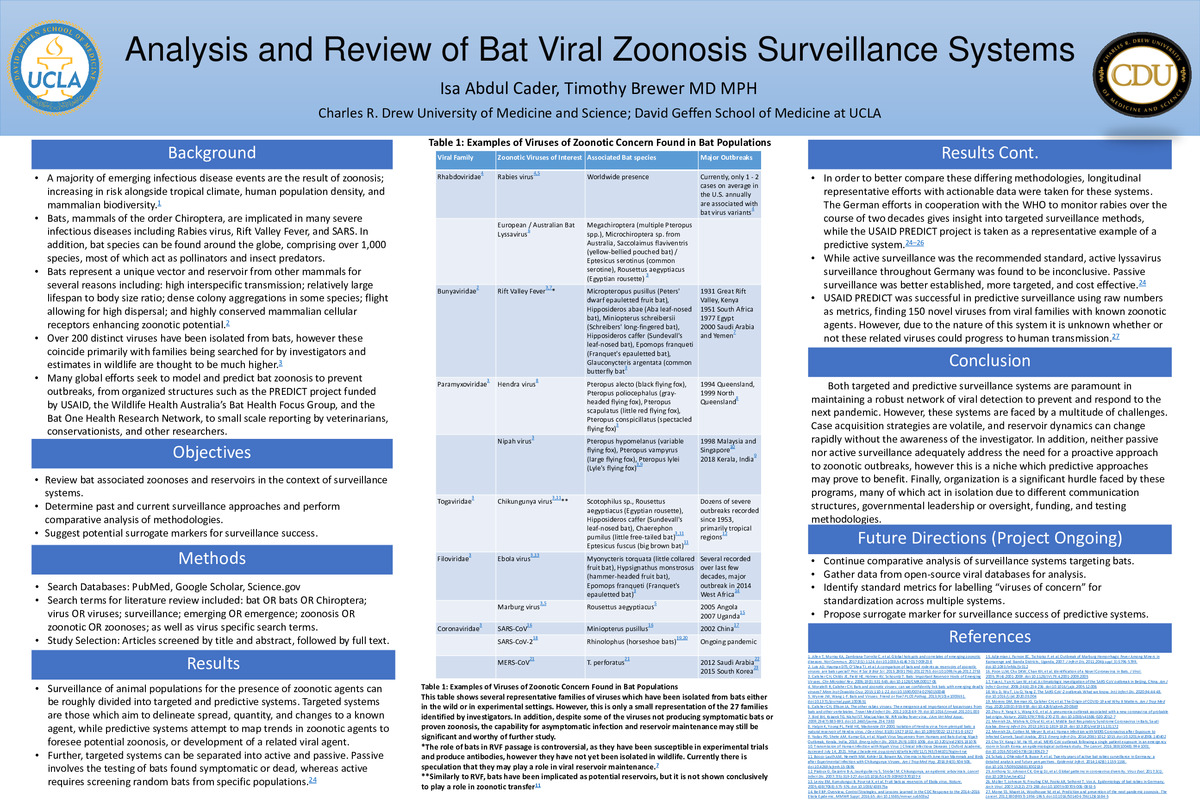-
Author
Isa Abdul Cader -
PI
Timothy Brewer MD MPH
-
Co-Author
-
Title
Analysis and Review of Bat Viral Zoonosis Surveillance Systems
-
Program
STTP
-
Other Program (if not listed above)
-
Abstract
Background
In light of the ongoing SARS-CoV-2 pandemic, there has been an increased public awareness and attention to the need for systems and protocols to proactively address the risks of severe zoonotic outbreaks. A majority of emerging infectious disease events are the result of zoonosis; increasing in risk alongside tropical climate, human population density, and mammalian biodiversity.1 Essential to the understanding and prevention of these EIDs is the investigation of their most common hosts and reservoirs. Bats, mammals of the order Chiroptera, are implicated in many severe infectious diseases including Rabies virus, Rift Valley Fever, and SARS. In addition, bat species can be found around the globe, comprising over 1,000 species, most of which act as pollinators and insect predators. Bats represent a unique vector and reservoir from other mammals for several reasons including: high interspecific transmission; relatively large lifespan to body size ratio; dense colony aggregations in some species; flight allowing for high dispersal; and highly conserved mammalian cellular receptors enhancing zoonotic potential.2
Over 200 distinct viruses have been isolated from bats, however these coincide primarily with families being searched for by investigators, and estimates in wildlife are thought to be much higher.3 Many global efforts seek to model and predict bat zoonosis to prevent outbreaks, from organized structures such as the PREDICT project funded by USAID, the Wildlife Health Australia’s Bat Health Focus Group, and the Bat One Health Research Network, to small scale reporting by veterinarians, conservationists, and other researchers.
Objectives
Review bat associated zoonoses and reservoirs in the context of surveillance systems.
Determine past and current surveillance approaches and perform comparative analysis of methodologies.
Suggest potential surrogate markers for surveillance success.
Methods
Search Databases: PubMed, Google Scholar, Science.gov
Search terms for literature review included: bat OR bats OR Chiroptera; virus OR viruses; surveillance; emerging OR emergence; zoonosis OR zoonotic OR zoonoses; as well as virus specific search terms.
Study Selection: Articles screened by title and abstract, followed by full text.
Results
In large scale analyses of bat viruses, 27 families were identified. However, these are not necessarily proven zoonoses, and may instead play a role in reservoir maintenance. While active surveillance was the recommended standard, active lyssavirus surveillance throughout Germany was found to be inconclusive. Passive surveillance was better established, more targeted, and cost effective. USAID PREDICT was successful in predictive surveillance using raw numbers as metrics, finding 150 novel viruses from viral families with known zoonotic agents. However, due to the nature of this system it is unknown whether or not these related viruses could progress to human transmission.
Conclusion
Surveillance protocols have to be written in accordance specifically with the pathogen of interest as well as the host species in mind. However, based on data from various surveillance efforts, the most robust systems would be those which combine predictive and targeted methodologies, as well as involve both international leadership and local specialists for insight into reservoir populations. Ongoing work in this study will include gathering data from these surveillance programs for analysis, continuing literature review for comparative analysis of systems, and developing a potential surrogate marker by which to standardize metrics of efficacy for surveillance success.
-
PDF
-
Zoom
https://uclahs.zoom.us/j/7645153921?pwd=RWhZN3VtTllSaDl6YisrakRsTGlXQT09

